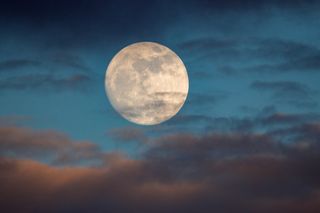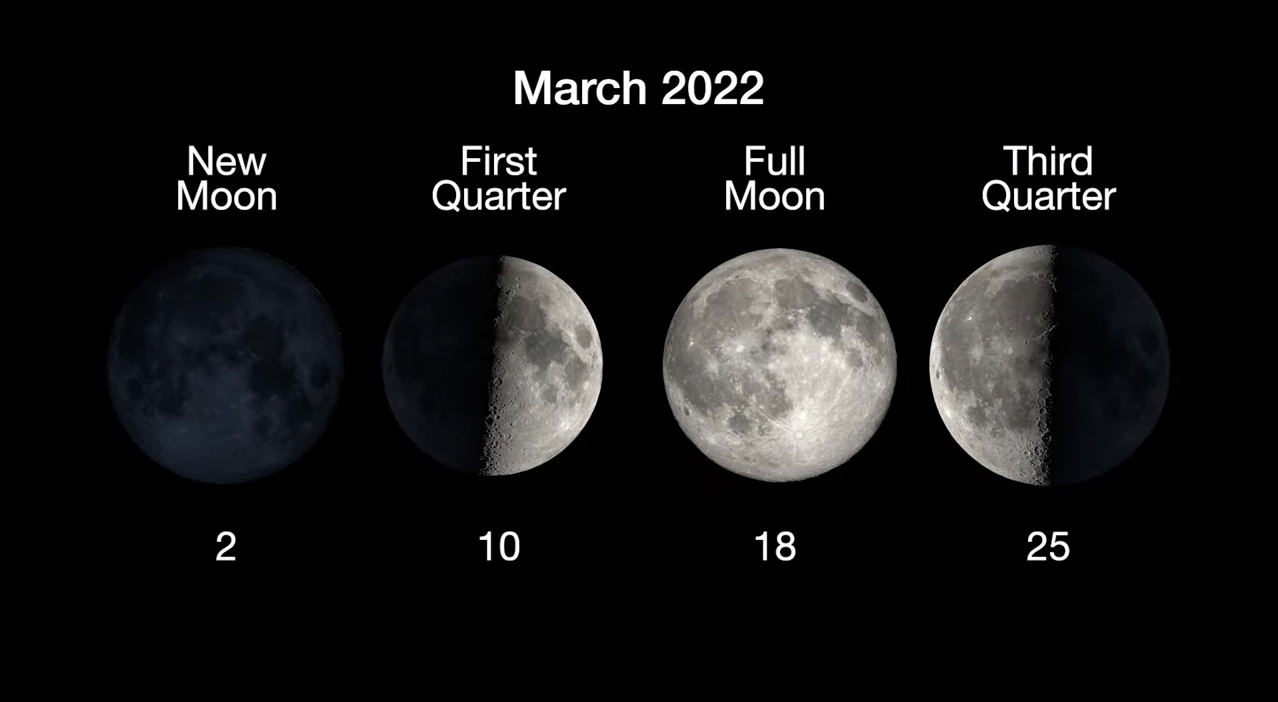Choral Reading for Kitten's First Full Moon
Full moon calendar 2022: When to see the next full moon

The side by side full moon will occur on Friday, March 18 at 3:17 am. (0717 GMT), but the moon will appear full the night before and after its pinnacle to the casual stargazer. The March full moon is likewise known every bit the Full Worm Moon.
The full moon shows its face to Earth about once a month. Well, sort of.
Most of the time, the full moon isn't perfectly total. We always see the same side of the moon, but part of information technology is in shadow, due to the moon'southward rotation. Merely when the moon, Earth and the sunday are perfectly aligned is the moon 100% full, and that alignment produces a lunar eclipse.
Related: Night sky, February 2022: What you can run across for the residuum of this calendar month
When is the full moon? Calendar dates for 2022
This is when full moons volition occur in 2022, according to NASA:
| Engagement | Name | U.South. Eastern Time | GMT |
|---|---|---|---|
| Jan 17 | Wolf Moon | 6:48 p.k. | 23:48 |
| Feb 16 | Snow Moon | eleven:57 a.m. | sixteen:57 |
| March 18 | Worm Moon | 3:17 am. | 07:17 |
| April 16 | Pink Moon | two:55 p.chiliad. | 18:55 |
| May 16 | Flower Moon | 12:xiv a.m. | 04:14 |
| June 14 | Strawberry Moon | 7:52 a.chiliad. | 11:52 |
| July 13 | Buck Moon | ii:37 p.m. | 18:37 |
| August 11 | Sturgeon Moon | nine:36 p.m. | 01:36 Aug. 12 |
| September ten | Harvest Moon | five:59 a.m. | 09:59 |
| October 9 | Hunter'southward Moon | 4:55 p.chiliad. | xx:55 |
| November 8 | Beaver Moon | vi:02 a.m. | xi:02 |
| December vii | Cold Moon | 11:08 p.m. | four:08 (Dec. 8) |
The 2022 full moon names explained
Many cultures accept given distinct names to each month's full moon. The names were applied to the entire month in which each occurred. The Farmer's Almanac lists several names that are normally used in the United States. At that place are some variations in the moon names, but in general, the same ones were used among the Algonquin tribes from New England on west to Lake Superior. European settlers followed their ain customs and created some of their own names.
Other Native American people had unlike names. In the book "This Day in Due north American Indian History" (Da Capo Printing, 2002), author Phil Konstantin lists more than 50 native peoples and their names for total moons. He as well lists them on his website, AmericanIndian.net.
Amateur astronomer Keith Cooley has a brief list of the moon names of other cultures, including Chinese and Celtic, on his website.
Chinese moon names:
| Calendar month | Name | Month | Name |
|---|---|---|---|
| January | Holiday Moon | July | Hungry Ghost Moon |
| February | Budding Moon | August | Harvest Moon |
| March | Sleepy Moon | September | Chrysanthemum Moon |
| April | Peony Moon | October | Kindly moon |
| May | Dragon Moon | November | White Moon |
| June | Lotus Moon | December | Bitter Moon |
Full moon names oft correspond to seasonal markers, and then a Harvest Moon occurs at the end of the growing season, in September or Oct, and the Cold Moon occurs in frosty Dec. At least, that's how it works in the Northern Hemisphere.
In the Southern Hemisphere, where the seasons are switched, the Harvest Moon occurs in March and the Cold Moon is in June. Co-ordinate to Earthsky.org, these are common names for full moons southward of the equator.
January: Hay Moon, Buck Moon, Thunder Moon, Mead Moon
February (mid-summer): Grain Moon, Sturgeon Moon, Ruby-red Moon, Wyrt Moon, Corn Moon, Dog Moon, Barley Moon
March: Harvest Moon, Corn Moon
Apr: Harvest Moon, Hunter's Moon, Claret Moon
May: Hunter'southward Moon, Beaver Moon, Frost Moon
June: Oak Moon, Cold Moon, Long Night's Moon
July: Wolf Moon, Old Moon, Ice Moon
August: Snow Moon, Storm Moon, Hunger Moon, Wolf Moon
September: Worm Moon, Lenten Moon, Crow Moon, Sugar Moon, Chaste Moon, Sap Moon
October: Egg Moon, Fish Moon, Seed Moon, Pink Moon, Waking Moon
November: Corn Moon, Milk Moon, Blossom Moon, Hare Moon
December: Strawberry Moon, Honey Moon, Rose Moon
The phases of the moon explained with dates

The moon is a sphere that travels once around Earth every 27.3 days. Information technology also takes about 27 days for the moon to rotate on its axis. So, the moon always shows u.s.a. the same face; in that location is no single "dark side" of the moon. Every bit the moon revolves around World, it is illuminated from varying angles past the sun — what nosotros see when we look at the moon is reflected sunlight. On average, the moon rises about 50 minutes later each mean solar day, which means sometimes it rises during daylight and other times at night.
There are four phases of the moon, new moon, offset quarter moon, total moon and third quarter moon.
At new moon, the moon is between Earth and the sun, so that the side of the moon facing toward us receives no straight sunlight, and is lit only past dim sunlight reflected from Earth.
A few days later on, as the moon moves effectually Globe, the side we can see gradually becomes more illuminated by directly sunlight. This thin sliver is called the waxing crescent.
A week afterwards the new moon, the moon is 90 degrees away from the dominicus in the sky and is half-illuminated from our point of view — what we call first quarter because it is near a quarter of the mode around Earth.
A few days later, the expanse of illumination continues to increase. More than half of the moon'south face appears to exist getting sunlight. This phase is called a waxing gibbous moon.
When the moon has moved 180 degrees from its new moon position, the sun, Globe and the moon form a line. The moon'southward disk is as shut equally information technology can be to existence fully illuminated by the sun, then this is called total moon.
Next, the moon moves until more than than half of its face appears to exist getting sunlight, but the amount is decreasing. This is the waning gibbous phase.
Days afterward, the moon has moved another quarter of the manner around Earth, to the tertiary quarter position. The sun's light is now shining on the other half of the visible confront of the moon.
Next, the moon moves into the waning crescent phase as less than half of its face appears to be getting sunlight, and the amount is decreasing.
Finally, the moon moves back to its new moon starting position. Because the moon's orbit is non exactly in the aforementioned plane equally Earth'south orbit around the sun, they rarely are perfectly aligned. Usually the moon passes to a higher place or beneath the sun from our vantage point, merely occasionally it passes right in forepart of the lord's day, and we get an eclipse of the lord's day.
Each full moon is calculated to occur at an exact moment, which may or may non be near the time the moon rises where you lot are. So when a full moon rises, information technology's typically doing so some hours before or after the actual time when it'south technically full, but a casual skywatcher won't discover the difference. In fact, the moon volition often expect roughly the same on ii consecutive nights surrounding the total moon.
Lunar eclipses of 2022
Lunar eclipses are inextricably tied to the full moon.
When the moon is in its full phase, information technology is passing behind the Earth with respect the lord's day and can laissez passer through Earth's shadow, creating a lunar eclipse. When the moon is fully within the Earth'southward shadow, nosotros encounter a full lunar eclipse. At other times, the moon only partially passes through the Earth'southward shadow in what is known as a partial, or even penumbral lunar eclipse (when the moon simply skirts through the outermost region of Globe's shadow).
In 2022, there are ii lunar eclipses: A total lunar eclipse on May 16 and a total lunar eclipse on Nov. 8.
The total lunar eclipse of May 16 will exist visible across North and South America, Europe and Africa. It will begin at ix:32 p.m. EDT (0132 GMT) and last nearly v hours and xviii minutes, according to NASA's Eclipse website. The eclipse will peak at 12:12 a.m. EDT (0412 on May 17 GMT).
The total lunar eclipse of November. 8 will be visible across Asia, Commonwealth of australia, the Pacific Body of water and the Americas. It will begin at 3:02 a.grand. EST (0802 GMT) and last about 5 hours, 53 minutes, with totality lasting 1 hour, 24 minutes, according to NASA. It volition pinnacle at six a.chiliad. EST (1100 GMT).
Because the moon's orbit effectually the Globe is tilted, it does non line up with Earth'due south shadow every month and we practise not accept a lunar eclipse each month.
Solar eclipses of 2022
When the moon is in its "new" phase, it passing between the World and the sun, and then the side facing the Earth appears dark.
Occasionally, the moon's orbit lines up with the dominicus in such away that role or all of the sun can exist blocked by the moon, as viewed from Earth. When the moon completely blocks the sun'due south disk, we see a total solar eclipse during the 24-hour interval, which can be a truly monumental site. Other times, the moon can only partially block the sun in a fractional solar eclipse.
The moon can even create a "band of burn down" solar eclipse when it passes straight in forepart the dominicus, only is at a betoken in its orbit that is too far from Earth to fully cover the lord's day's disk. This leaves a ring, or "annulus," around the moon to create what is chosen an annular solar eclipse.
There are ii solar eclipses in 2022: a partial solar eclipse on Apr 30 and a partial solar eclipse on October. 25.
The partial solar eclipse of Apr 30 will be visible from parts of the southeastern Pacific Ocean and southern South America. It will begin at two:45 p.m. EDT (1845 GMT) and terminate at 6:37 p.thousand. EDT (2237 GMT), according to NASA's solar eclipse folio.
The partial solar eclipse of Oct. 25 will be visible from parts of Europe, northeast Africa, the Middle E and southwest asia. It will begin at iv:58 a.m. EST (0858 GMT) and end at 9:02 a.m. EST (1302 GMT).
More full moon and dark sky resource
- Space calendar 2022: Rocket launches, heaven events, missions & more!
- NASA'south Heaven Events Calendar
- The 10 Must-Run across Skywatching Events to Look For in 2022
Join our Space Forums to keep talking space on the latest missions, night sky and more! And if you have a news tip, correction or comment, let us know at: community@infinite.com.
Source: https://www.space.com/16830-full-moon-calendar.html
0 Response to "Choral Reading for Kitten's First Full Moon"
Post a Comment